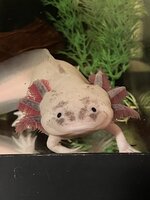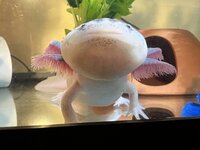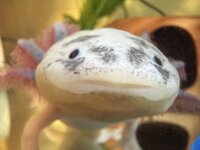professorfluffygills
New member
I’m having a terrible time with my axolotl tank. I cycled the tank last summer with Professor in it because I bought her without much advance planning since there were only a few axies available at my LFS. She is an adult now and overall doing well, gills are fluffy, she’s nice and chonk, silly and overall pretty much perfect. But I can’t get a handle on the ammonia and nitrates in the tank. Here are the facts:
20-gal tank w/sponge filter, cycling since last July
One adult axolotl, two babies in breeder boxes. (problem existed before the babies but I didn’t realize the extent of it until they came, long story)
Consistent ammonia 0.5-1.0 (neutralizing w/prime and adding Seachem Seed, free ammonia reader always negative)
0 nitrites, always
Nitrates 40-80 without variation, even after 50% water change. I know this sounds mathematically impossible, welcome to my house of wonders
pH never above 6.6 (inexplicably dropped lower yesterday, 6.0-6.4), tap water 7.6. How water with a pH of 7.6 enters this tank and immediately drops to 6.6 is beyond me. I’m starting to think the tank is haunted.
GH 3 (53), same as tap water, ideally should be 7-14
Ammonia/nitrite/nitrate values have been double checked at LFS with their nifty little machine
Temp always 59-64F
Barebottom tank (no substrate)
Doing 40-50% water change every other day, just chasing my tail
My dilemma:
In the absence of any other explanation, all I can figure is that the presence of ammonia is likely driving down the pH.
I need to raise the pH or I will never grow enough Nitrosomonas to tackle this ammonia. It’s hard enough at current temps, but at this pH it’s pretty much hopeless.
If I increase the hardness, I believe that will raise the pH. However, if I raise the pH, the ammonia will become more toxic. If I don't raise the pH, I'll never get rid of the ammonia.
So I am in a total catch-22 situation with this tank. My only saving grace is that I’m currently cycling a 40 gallon that I hope to move everyone into while I figure out how to save the smaller tank. I’ve been to my LFS many times with questions, they are generally very knowledgeable but I’m finding their expertise is mainly about tropical FW and marine tanks, not cold water tanks, so they are only helpful to a point.
Can anyone address the reason why I can’t get the ammonia under control? Did the low temps prevent the bacteria from growing? Or is it a matter of not having enough surface matter for the bacteria to grow on given the fact that I don’t have any substrate? If so, how do I fix that?
Also, why, oh why, can I not get the nitrates under control. They never change. Ever. There is nary a speck of waste or uneaten food in this tank because I am obsessively sucking it out with the turkey baster thing. It is pristine. You could eat off the floor in there. And yet, nitrates. For days. I can hear them laughing at me. Even the stubborn ammonia will decrease appropriately after a water change. Not these guys, oh, no.
And the pH problem. Do I raise it and risk toxifying the ammonia even further, or do I leave it as it is and never grow the bacteria I need to take care of the ammonia? How would I even raise it, or maintain it at that level if I did?
I know this is a very long post and thank you if you’ve made it this far. If anyone more knowledgeable than me can provide any advice or insight, it would be so appreciated. If there are any flaws in my logic or knowledge, I’m happy to learn – I’ve learned a lot over the past year but I’m far from an expert. I love my axolotls dearly and I want to provide the best for them. I’m just losing my mind and don’t know anyone else I can ask.
TIA, very much!
(attaching pics of Professor "Fessie," just for fun.)
20-gal tank w/sponge filter, cycling since last July
One adult axolotl, two babies in breeder boxes. (problem existed before the babies but I didn’t realize the extent of it until they came, long story)
Consistent ammonia 0.5-1.0 (neutralizing w/prime and adding Seachem Seed, free ammonia reader always negative)
0 nitrites, always
Nitrates 40-80 without variation, even after 50% water change. I know this sounds mathematically impossible, welcome to my house of wonders
pH never above 6.6 (inexplicably dropped lower yesterday, 6.0-6.4), tap water 7.6. How water with a pH of 7.6 enters this tank and immediately drops to 6.6 is beyond me. I’m starting to think the tank is haunted.
GH 3 (53), same as tap water, ideally should be 7-14
Ammonia/nitrite/nitrate values have been double checked at LFS with their nifty little machine
Temp always 59-64F
Barebottom tank (no substrate)
Doing 40-50% water change every other day, just chasing my tail
My dilemma:
In the absence of any other explanation, all I can figure is that the presence of ammonia is likely driving down the pH.
I need to raise the pH or I will never grow enough Nitrosomonas to tackle this ammonia. It’s hard enough at current temps, but at this pH it’s pretty much hopeless.
If I increase the hardness, I believe that will raise the pH. However, if I raise the pH, the ammonia will become more toxic. If I don't raise the pH, I'll never get rid of the ammonia.
So I am in a total catch-22 situation with this tank. My only saving grace is that I’m currently cycling a 40 gallon that I hope to move everyone into while I figure out how to save the smaller tank. I’ve been to my LFS many times with questions, they are generally very knowledgeable but I’m finding their expertise is mainly about tropical FW and marine tanks, not cold water tanks, so they are only helpful to a point.
Can anyone address the reason why I can’t get the ammonia under control? Did the low temps prevent the bacteria from growing? Or is it a matter of not having enough surface matter for the bacteria to grow on given the fact that I don’t have any substrate? If so, how do I fix that?
Also, why, oh why, can I not get the nitrates under control. They never change. Ever. There is nary a speck of waste or uneaten food in this tank because I am obsessively sucking it out with the turkey baster thing. It is pristine. You could eat off the floor in there. And yet, nitrates. For days. I can hear them laughing at me. Even the stubborn ammonia will decrease appropriately after a water change. Not these guys, oh, no.
And the pH problem. Do I raise it and risk toxifying the ammonia even further, or do I leave it as it is and never grow the bacteria I need to take care of the ammonia? How would I even raise it, or maintain it at that level if I did?
I know this is a very long post and thank you if you’ve made it this far. If anyone more knowledgeable than me can provide any advice or insight, it would be so appreciated. If there are any flaws in my logic or knowledge, I’m happy to learn – I’ve learned a lot over the past year but I’m far from an expert. I love my axolotls dearly and I want to provide the best for them. I’m just losing my mind and don’t know anyone else I can ask.
TIA, very much!
(attaching pics of Professor "Fessie," just for fun.)



